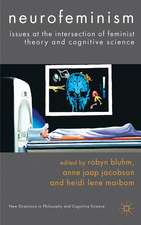Toward a New Psychology of Gender: A Reader
Editat de Mary M. Gergen, Sara N. Davisen Limba Engleză Paperback – 26 dec 1996
Preț: 565.68 lei
Preț vechi: 865.54 lei
-35% Nou
Puncte Express: 849
Preț estimativ în valută:
108.26€ • 112.60$ • 89.37£
108.26€ • 112.60$ • 89.37£
Carte tipărită la comandă
Livrare economică 15-29 aprilie
Preluare comenzi: 021 569.72.76
Specificații
ISBN-13: 9780415913089
ISBN-10: 041591308X
Pagini: 640
Dimensiuni: 178 x 254 x 27 mm
Greutate: 1.18 kg
Ediția:1
Editura: Taylor & Francis
Colecția Routledge
Locul publicării:Oxford, United Kingdom
ISBN-10: 041591308X
Pagini: 640
Dimensiuni: 178 x 254 x 27 mm
Greutate: 1.18 kg
Ediția:1
Editura: Taylor & Francis
Colecția Routledge
Locul publicării:Oxford, United Kingdom
Notă biografică
State University, Delaware County Campus. She is the editor of Feminist Thought and the Structure of Knowledge and is a founding member of the Taos Institute. Sara Davis is Assistant Professor of Psychology and is affiliated with the Women's Studies Program at Rosemont College.
Recenzii
"[An] enormously rich volume . . . The wealth of this volume comes from the inclusion of cross-cultural work, literary-critical trends, analyses of masculinity, offerings from gay and lesbian perspectives, family and clinical studies--thirty-two papers in all. . . . A review of this book cannot do it justice. . . . [R]eading this multidimensional book makes one envision a marvelous common ground between feminists and phenomenologists." -- Journal of Phenomenological Psychology
Cuprins
Introduction Toward a New Psychology of Gender, Sara N. Davis, Mary Gergen; Part I Linking Feminism and Psychology; Chapter 1 Regarding Gender, Janis S. Bohan; Chapter 2 Feminist Poststructuralism and Discourse Analysis, Nicola Gavey; Chapter 3 Feminism and Psychology, Mary Brown Parlee; Part II Connecting With Others; Chapter 4 Making Sense, Margery B. Franklin; Chapter 5 Writing Ethnography, Carol B. Stack; Chapter 6 Dialogue with Guatemalan Indian Women, M. Brinton Lykes; Chapter 7 Linguistic Repertoires and Literary Criticism, Margaret Wetherell; Part III Challenging Differences; Chapter 8 Femininity as Performance, Valerie Walkerdine; Chapter 9 Children and Gender, Barrie Thorne; Chapter 10 Life Stories, Mary Gergen; Chapter 11 Masculinity as Homophobia, Michael S. Kimmel; Part IV Open to Interpretation; Chapter 12 Post-Colonial Feminism and the Veil, Lama Abu Odeh; Chapter 13 “They Have Eyes and See Not”, Dafna N. Izraeli; Chapter 14 Agreeing to Differ, Mary Crawford; Chapter 15 Corpses, Lepers, and Menstruating Women, Nancy Datan; Chapter 16 New Voices, New Visions, Laura S. Brown; Part V Contested Relations; Chapter 17 Forgotten Forms of Close Combat, Jane Flax; Chapter 18 The Meaning of Motherhood in Black Culture and Black Mother/Daughter Relationships, Patricia Hill Collins; Chapter 19 Like Family, Michael A. Messner; Part VI Sexuality and Pleasure; Chapter 20 Sexual Biology and The Symbolism of The Natural, Leonore Tiefer; Chapter 21 Sexuality, Schooling, and Adolscent Females, Michelle Fine; Chapter 22 Virgins and Queers, Celia Kitzinger, Sue Wilkinson; Part VII Gender & Identity; Chapter 23 Anorexia Nervosa, Susan Bordo; Chapter 24 Gender Identities at the Crossroads of Masculinity and Physical Disability, Thomas J. Gerschick, Adam Stephen Miller; Part VIII Power; Chapter 25 Women, Aids, and Power in Heterosexual Sex, Lesley Miles; Chapter 26 Gender Displays and Men’s Power, Pierrette Hondagneu-Sotelo, Michael A. Messner; Chapter 27 Essentialism, Women, and War, Susan Oyama; Chapter 28 Feminist Politicization, bell hooks; Part XI Breaking Out; Chapter 29 Disappearances, Silences, and Anxious Rhetoric, Jeanne Marecek; Chapter 30 Discourse in the Mirrored Room, Rachel T. Hare-Mustin; Chapter 31 Love And Violence, Virginia Goldner, Peggy Penn, Marcia Sheinberg, Gillian Walker; Part X Postscript; Chapter 32 Skipping Stone, Mary Gergen;














